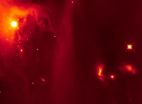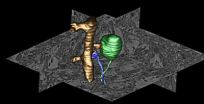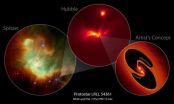(Press-News.org) The proteins that have now been identified shouldn't actually exist. Nevertheless, they build the core of cellular aggregates whose identity has been enigmatic until now. These aggregates are typically associated with hereditary neurodegenerative diseases including variants of frontotemporal dementia (FTD), also known as frontotemporal lobar degeneration (FTLD), and amyotrophic lateral sclerosis (ALS). They are likely to be damaging and might be a target for therapy.
FTD and ALS are part of a group of neurodegenerative diseases that show a broad and overlapping variety of symptoms: Patients often suffer from dementia, personality changes and may also be affected by language abnormalities and movement disorders. The problems often arise before the age of 65 without a clear cause. However, about 30 percent of cases are linked to a genetic cause. In Europe approximately 10 percent of patients show a common genetic feature: In their DNA (the carrier of the genetic code) a particular short sequence appears in numerous copies one after another. Furthermore, proteins of unknown identity accumulate inside the brain of these patients. As it turns out both findings are directly related – that is what the team of researchers including molecular biologists Dieter Edbauer and Christian Haass has now been able to show.
"We have found that the proteins are linked to a genetic peculiarity which many patients have in common. At a certain location inside the gene C9orf72 there are several hundred repeats of the sequence GGGGCC, while healthy people display less than 20 such copies," explains Prof. Edbauer, who researches at the DZNE and the LMU. "But it is surprising that these proteins are actually made, because these repeats fall into a region of the DNA that should not be translated into proteins."
An area of DNA assumed to be silent
The DNA holds the blueprints for building proteins. In general, the beginning of such a blueprint is indicated by a certain molecular start signal, but the usual signal is missing in this case. The region of DNA comprising the numerous repeats should therefore not be translated into proteins. It seems that the process of protein synthesis is initiated in a non-textbook way. "Although quite rare there are two known alternatives to the common mechanism. Which procedure applies here, we don't know yet," says Prof. Haass, Site Speaker of the DZNE in Munich and chair of Metabolic Biochemistry at LMU.
Nevertheless, in cell culture experiments the researchers were able to show that long repeats of the sequence GGGGCC may in fact lead to the production of proteins, even though the usual start signal is missing. Furthermore, they identified the same proteins in the particles that typically accumulate in the brain of patients. The scientist could also identify their composition: They turned out to be dipeptid-repeat proteins, which comprise a very large number of identical building blocks.
"These are very extraordinary proteins that usually don't show-up in the organism," Edbauer notes. "As far as we know, they are completely useless and scarcely soluble. Therefore, they tend to aggregate and seem to damage the nerve cells. We haven't formally proven toxicity, but there is ample evidence." Because of their peculiarity these proteins might be an interesting target for new therapies. "As the mechanism of their production is so unusual, we may find ways to inhibit their synthesis without interfering with the formation of other proteins. One could also try to block their aggregation and accelerate their decomposition."
The scientists have applied for a patent and are pursuing a major goal. "At the DZNE in Munich it is our dream to develop a therapy against these devastating diseases," Haass and Edbauer conclude.
###
Original Publication:
„The C9orf72 GGGGCC Repeat is Translated into Aggregating Dipeptide-Repeat Proteins in FTLD/ALS", Kohji Mori, Shih-Ming Weng, Thomas Arzberger, Stephanie May, Kristin Rentzsch, Elisabeth Kremmer, Bettina Schmid, Hans A. Kretzschmar, Marc Cruts, Christine Van Broeckhoven, Christian Haass, Dieter Edbauer, Science Express, doi: 10.1126/science.1232927.
Translation error tracked in the brain of dementia patients
Scientists identify enigmatic aggregates linked to neurodegenerative diseases
2013-02-08
ELSE PRESS RELEASES FROM THIS DATE:
Stress at work very unlikely to cause cancer
2013-02-08
Work-related stress is not linked to the development of colorectal, lung, breast or prostate cancers, a study published today on bmj.com suggests.
Around 90% of cancers are linked to environmental exposures and whilst some exposures are well recognised (such as UV radiation and tobacco smoke), others are not (psychological factors such as stress).
Stress can cause chronic inflammation which has been shown to have various roles in the development of cancer, plus stressed individuals are more likely to smoke, consume excessive amounts of alcohol and be obese – all ...
43 percent reduction in deaths from paracetamol due to smaller pack sizes
2013-02-08
Research: Long term effect of reduced pack sizes of paracetamol on poisoning deaths and liver transplant activity in England and Wales: interrupted time series analysis
The number of deaths and liver transplants due to paracetamol overdoses has significantly reduced thanks to UK legislation to make pack sizes smaller, a paper published today on bmj.com suggests.
Paracetamol overdoses are a common method of suicide and frequent cause of liver damage. In September 1998, a new legislation was introduced by the UK Government which restricted pack sizes to a maximum of ...
UF researchers include humans in most comprehensive tree of life to date
2013-02-08
GAINESVILLE, Fla. --- An international team of scientists including University of Florida researchers has generated the most comprehensive tree of life to date on placental mammals, which are those bearing live young, including bats, rodents, whales and humans.
Appearing Thursday in the journal Science, the study details how researchers used both genetic and physical traits to reconstruct the common ancestor of placental mammals, the creature that gave rise to many mammals alive today. The data show that contrary to a commonly held theory, the group diversified after ...
New study highlights Chagas disease as a growing health and socio-economic challenge
2013-02-08
WASHINGON, D.C.—February 7, 2013—Today, The Lancet Infectious Diseases published a new report that examines the global economic burden of Chagas disease. In the first study of its kind, researchers measured the health and economic impact of Chagas disease and found that the total economic burden of Chagas disease matches or exceeds that of many more well-known diseases such as rotavirus, Lyme disease and cervical cancer.
Chagas disease infects an estimated 10 million people worldwide, with most cases occurring in Latin America. It is a parasitic infection transmitted ...
For drug makers, new 3-D control opens wealth of options
2013-02-08
New Haven, Conn.— A team of scientists anchored at Yale University has demonstrated a new, highly versatile approach for quickly assembling drug-like compounds, establishing a broad new route to drug discovery and medical treatment. They report their results in the journal Science on Feb 8.
Drug molecules interact with their targets, such as proteins or enzymes, by attaching to them in a way that neutralizes the target's undesirable effects in the body. This is sometimes called the "lock-and-key" method. The new approach offers scientists far greater control over the ...
Hubble captures strobe flashes from a young star
2013-02-08
The cause of the fireworks seen in this Hubble image and video is hidden behind a dense disc and envelope of dust. However, astronomers think that the strobe effect is due to periodic interactions between two newly-formed stars that are gravitationally bound to each other.
These two stars drag material inwards from a surrounding disc of gas and dust. Astronomers propose that the light flashes seen in this video are due to this material suddenly being dumped onto the growing stars as they near one another in their orbits, unleashing a blast of radiation.
"The protostar ...
Hastings Center resources chart progress in debate over medical research with animals
2013-02-08
The scientific and ethical debate over the use of animals in medical research has raged for years, but perspectives are shifting, viewpoints are becoming more nuanced, and new initiatives are seeking alternatives to animal testing, according to a special report by The Hastings Center, "Animal Research Ethics: Evolving Views and Practices." The report is available on a new Web site, animalresearch.thehastingscenter.org, a hub of educational information that defines and interprets this changing landscape.
These resources are the outcome of a project on the ethics of medical ...
Excess protein linked to development of Parkinson's disease
2013-02-08
Researchers at the University of California, San Diego School of Medicine say overexpression of a protein called alpha-synuclein appears to disrupt vital recycling processes in neurons, starting with the terminal extensions of neurons and working its way back to the cells' center, with the potential consequence of progressive degeneration and eventual cell death.
The findings, published in the February 6, 2013 issue of the Journal of Neuroscience, have major implications for more fully understanding the causes and mechanisms of Parkinson's disease (PD), a neurodegenerative ...
NASA telescopes discover strobe-like flashes in a suspected binary protostar
2013-02-08
VIDEO:
This video, created from a sequence of images from the Hubble Space Telescope, shows a pulse of light emanating from the protostellar object LRLL 54361. Most if not all of...
Click here for more information.
Two of NASA's great observatories, the Spitzer and Hubble space telescopes, have teamed up to uncover a mysterious infant star that behaves like a strobe light.
Every 25.34 days, the object, designated LRLL 54361, unleashes a burst of light. Although a similar ...
The amazing amphibians and reptiles of the Philippine island Luzon
2013-02-08
A recent study of the amphibians and reptiles of Sierra Madre Mountain Range, northeastern Luzon, reveals a preliminary enumeration of more than 100 species that contribute to the unique biodiversity of the region. At present, the Luzon region's herpetological range stands at more than 150 species. Out of these, a total of 49 amphibian species have been documented, 44 of which are native and a remarkable 32 endemic. In the world of reptiles, Luzon can boast with 106 native species, 76 of which are unique to this region.
The catalogue published in the open access journal ...
LAST 30 PRESS RELEASES:
Making lighter work of calculating fluid and heat flow
Normalizing blood sugar can halve heart attack risk
Lowering blood sugar cuts heart attack risk in people with prediabetes
Study links genetic variants to risk of blinding eye disease in premature infants
Non-opioid ‘pain sponge’ therapy halts cartilage degeneration and relieves chronic pain
AI can pick up cultural values by mimicking how kids learn
China’s ecological redlines offer fast track to 30 x 30 global conservation goal
Invisible indoor threats: emerging household contaminants and their growing risks to human health
Adding antibody treatment to chemo boosts outcomes for children with rare cancer
Germline pathogenic variants among women without a history of breast cancer
Tanning beds triple melanoma risk, potentially causing broad DNA damage
Unique bond identified as key to viral infection speed
Indoor tanning makes youthful skin much older on a genetic level
Mouse model sheds new light on the causes and potential solutions to human GI problems linked to muscular dystrophy
The Journal of Nuclear Medicine ahead-of-print tip sheet: December 12, 2025
Smarter tools for peering into the microscopic world
Applications open for funding to conduct research in the Kinsey Institute archives
Global measure underestimates the severity of food insecurity
Child survivors of critical illness are missing out on timely follow up care
Risk-based vs annual breast cancer screening / the WISDOM randomized clinical trial
University of Toronto launches Electric Vehicle Innovation Ontario to accelerate advanced EV technologies and build Canada’s innovation advantage
Early relapse predicts poor outcomes in aggressive blood cancer
American College of Lifestyle Medicine applauds two CMS models aligned with lifestyle medicine practice and reimbursement
Clinical trial finds cannabis use not a barrier to quitting nicotine vaping
Supplemental nutrition assistance program policies and food insecurity
Switching immune cells to “night mode” could limit damage after a heart attack, study suggests
URI-based Global RIghts Project report spotlights continued troubling trends in worldwide inhumane treatment
Neutrophils are less aggressive at night, explaining why nighttime heart attacks cause less damage than daytime events
Menopausal hormone therapy may not pose breast cancer risk for women with BRCA mutations
Mobile health tool may improve quality of life for adolescent and young adult breast cancer survivors
[Press-News.org] Translation error tracked in the brain of dementia patientsScientists identify enigmatic aggregates linked to neurodegenerative diseases



